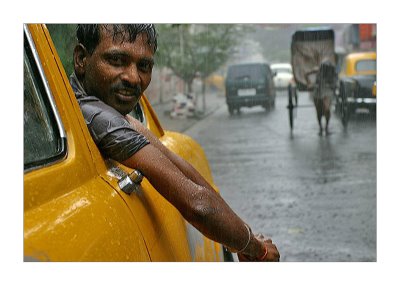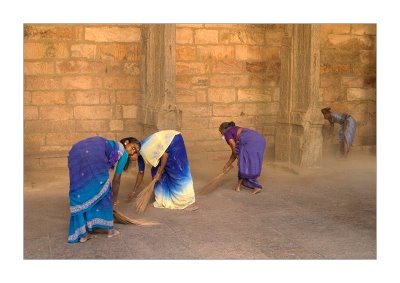An exhibition I had in England "Water and the Sacred"
a photographic exhibition by Claude Renault
The Charnwood Arts – Kala Kahani programme is delighted to be able to bring this premier of Claude Renault’s exhibition ‘Water and the Sacred’ to Charnwood. Kala Kahani is predominantly a literature based project so we would love to hear.......
.......Words From You!
11.12.06
A kid and a tank. Amber. Rajasthan

A kid diving into the sacred tank in Amber. The ancient Hindu village extends behind the imposing fortress, and is surprisinglyrich in unvisited marvels, like the Krishna temple, all carved in white marble. Beautiful, welcoming and peaceful. The water tank tradition is of the utmost importance in the arid and semi- desert Indian state of Rajasthan, The tank needs to be very deep, so a lot of stairs are geometrically built, a graphic delight.
7.11.06
Haridwar: Resting Sadhus. Uttaranchal

Coming from all over the country, often on foot, to the town of Haridwar, pilgrims and sadhus are overwhelmed by tiredness, and lay on the bare ground of the ghats, while others eat or attend to their children. I find these scenes as attractive as the place itself, better, the place would be inconceivable without its pulsing life, which often includes animals, as well as human beings. I feel myself completely at ease in these surroundings.
Mathura. On the Yamuna. Uttar Pradesh

Women drying up saris alongside the sacred Yamuna river in Mathura.
A long line of picturesque, pink ghats - with their steps leading to the water's edge, arched gateways and a temple, of course pink, extending along the right bank of the River Yamuna, emphasise the sacred character of the town of Mathura. The birth place of Lord Krishna, "the best known, best loved and most complex of Lord Vishnu's manifestations". Mathura is today an important place of pilgrimage.
An ancient city, Mathura's strategic location at the crossroads of various trade routes - that went westwards to West Asia and the Roman Empire; northwards, via Taxila, Pushkalavati and Purushapur to Central Asia and the Silk Route and eastwards to China - ensured its position as a centre of trade and a meeting point for many different cultures
Calcutta. Monsoon Puja. West Bengal
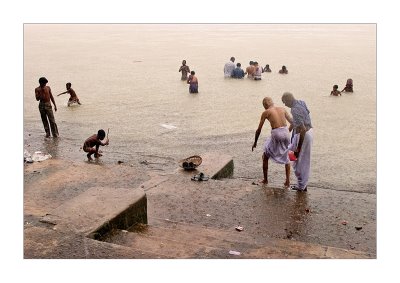
An image of a Puja on Babu ghats in Kolkata, along the banks of the Hooghly, a tributary of the Ganges. It was the monsoon season, but the warm climate doesn’t prevent people from living their usual lives. It was raining as I had never seen before.
The best time to visit any river in India is in the morning, and this is the busiest ghat at this time. A flurry of typically Indian activities begins at the crack of dawn as the mist rises and the sun falters over overnight clouds, to announce yet another day. Bathing. Worship. Commerce. Ceremonies of birth and death. Then, all of a sudden, the rain falls and falls and keeps on falling heavily.
Kolkata. taxi. West Bengal
Patna: Sleepy Sadhu. Bihar
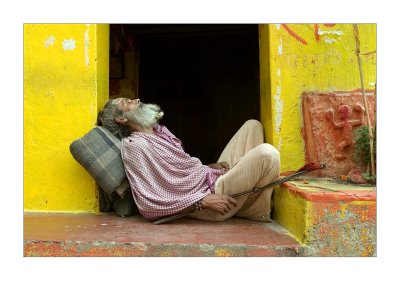
A sleepy sadhu at the door of a small temple in Patna. The Sadhu tradition has a long history. It consists of renouncing worldly ties in pursuit of higher values of life. Ideally a sadhu lives in the society but is detached from its pleasures and pains.
Sadhus typically survive on bhiksha (alms) provided by families, and on natural resources, and they spend much of their time in meditation.
Vaitheeswarankoil: Siram. Tamil Nadu

Siram is a small boy who came with his father, mother, brother and sister to visit and pray at the temple in Vaitheeswarankoil. The family was from Vellore. His hair had been shaved for the sacred occasion. His head is sprinkled with an antiseptic powder which is widely used after the ritual shavings.
Situated about 24 km. from Chidambaram, the temple is dedicated to Lord Shiva, who is worshipped as Vaitheeswaran or Vaidhyanadha Swamy. His consort is known as Thaiyal Nayaki.
Madurai: Pilgrims During Chitrai Festival. Tamil Nadu
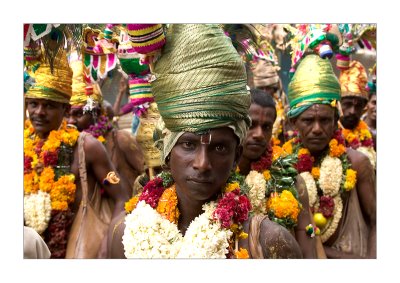
The Chitrai Festival in April/May is the most important one of the year. It celebrates the marriage of Meenakshi (Parvati) with Sundareswar (Lord Shiva). The two deities, riding on a golden bull and wearing pearl crowns, are brought on a spectacular procession around the town. Lord Alagar’s (Vishnu) procession to the bank of the Vaigai River on the full moon day is one of the most interesting events of the festival.
This picture was taken right in the middle of the street, going down to the rive
Pushkar: Water Rituals. Rajasthan

A woman performing her early morning Puja in Pushkar, opposite the main Ghats, in a rather secluded part of the sacred tank. It was amazing to observe how agile even older women were, when climbing and descending the high stone steps, urging to touch the water. The rituals were performed every day, accompanied by prayers and chants. A peaceful, enchanting scene.
Rishikesh: Old Rajasthani. Uttaranchal
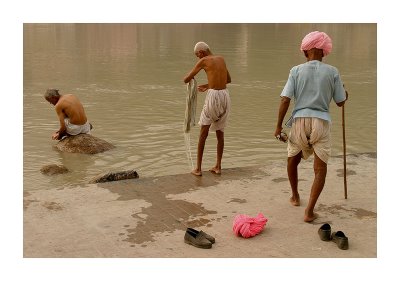
Three old pilgrims from Rajasthan made it to Rishikesh, going about during and after their ritual bath.
Rishikesh represents the Gateway to the Himalayas in the splendid Tehri-Garhwal region of Uttaranchal. The spectacle of the Ganges rushing through the Himalayan foothills is an awesome sight. Several temples dot the banks of the river at Rishikesh, which represents the site where Vishnu vanquished the demon Madhu.
Madurai. Sweepers in the Meenakshi temple.
Ritual. Omkareshwar. Madhya Pradesh
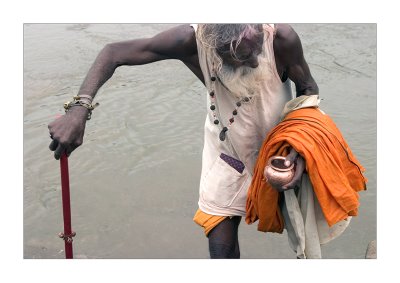
An elderly man coming out of the Narmada river, after having performed his Puja, in the town of Omkareshwar.
Omkareshwar, located in Madhya Pradesh, on the Mandhata hill on the banks of the Narmada, is one of the 12 revered Jyotirlinga shrines of Shiva.
There are two temples here, one to Omkareshwar and one to Amareshwar. Legend has it that the Vindhya mountain prayed to Shiva - Omkareshwara and was blessed here. Legend also has it that upon the request of the Devas, the Shivalinga split into two, one half being Omkareshwara and the other Amaleshwara or Amareshwar.
Calcutta. Little girl. West Bengal
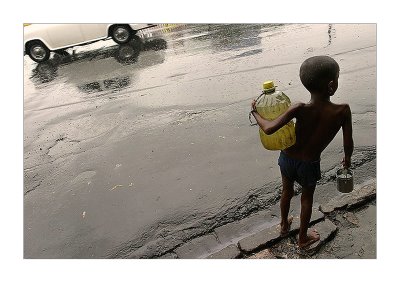
I was walking in Kolkata. Monsoon time. This little girl was waiting under the light rain to cross the busy Jawaharlal Nehru road, a big artery of Kolkata. She was going in the direction of the Maiden's, a big park.
In 1690, the site of Calcutta was chosen by Job Charnok, an agent of the East India Company, for a British trade settlement. The place was carefully selected, being protected by the Hooghly River on the west, a creek to the north, and by salt lakes about two and a half miles to the east. There were three large villages along the east bank of the river Ganges, named, Sutanuti, Gobindapur and Kalikata. These three villages were bought by the British from local land lords. The Mughal emperor granted the East India Company freedom of trade in return for a yearly payment of 3,000 rupees.
6.11.06
A golden Prayer. Amritsar. Punjab

A Sikh reading his sacred book alongside the tank of the Golden Temple. A minimalist shot, showing the reflection of the Golden Temple in Amritsar, literally, pool of nectar.
This piece of architecture draws on both Hindu and Moslem artistic styles, yet represents a unique co-evolution of the two. During the reign of Maharaja Ranjit Singh (1780-1839), Hari Mandir was richly ornamented with marble sculptures, golden gilding, and large quantities of precious stones. Within the sanctuary, on a jewel-studded platform, lies the Adi Grantha, the sacred scripture of the Sikhs. This scripture is a collection of devotional poems, prayers, and hymns composed by the ten Sikh gurus and various Moslem and Hindu saints. The image was shot the day before the 400th anniversary of when the Holy Book was first taken to its holy site. Beginning early in the morning and lasting until long past sunset, hymns were chanted to the accompaniment of flutes, drums, and stringed instruments.
An underground spring feeds the sacred lake, and throughout the day and night pilgrims immerse themselves in the water, a symbolic cleansing of the soul rather than an actual bathing of the body. Next to the temple complex are enormous pilgrims' dormitories and dining halls where all persons, irrespective of race, religion, or gender, are lodged and fed for free.
Gaumukh. saddhus at the sources of the Ganges
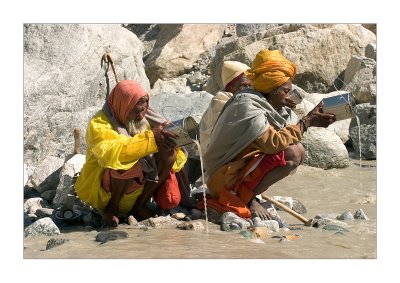
Three sadhus doing their Puja at the source of the Ganges, in Gaumukh (The cow's mouth). I went down with them. The Gangotri shrine is seen as the spiritual source of Hinduism's most sacred river, the Ganges. According to Hindu mythology, Ganga, the stream of life, was granted as a reward for King Bhaghirati's severe penance and the river is worshiped as a deity. The physical source of the river is at Gaumukh, 18 km south-east of Gangotri, along the Gangotri glacier. The temple at Gangotri is visited by thousands of pilgrims between May & November. It was built by a Gurkha Commander, Amar Singh Thapa, in the early 18th century.This happens to be along one of the most popular pilgrimage routes in the Indian Himalayas. .
Offerings. Omkareshwar. Madhya Pradesh

14th of August. A group of women performing the puja in the river Narmada, in Omkareshwar. The brown colour of the river, almost overflowing, is due to the Monsoon season. Omkareshwar, located in Madhya Pradesh, on the Mandhata hill on the banks of the Narmada, is one of the 12 revered Jyotirlinga shrines of Shiva. The river Narmada branches into two and forms the island Mandhata or Shivapuri in its center. The shape of the island resembles that of the visual representation of the Omkara sound, Om. There are two temples there, one to Omkareshwar and one to Amareshwar. The Omkareshwar temple built in the Nagara style is characterized by a lofty shikhara. There are also shrines to Annapurna and Ganesh.
Offering. Haridwar. Uttaranchal
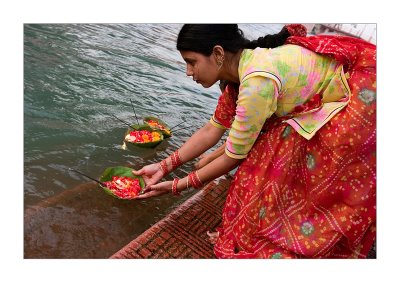
Evening. A pilgrim from Jodhpur, Rajastan is offering flowers to Ganga.
Ganga Pooja is a ritual worship of the river, considered very important by the local Pundas (priests). A Pooja is a ritual where offerings are made to the Gods, according to ancient religious rituals, each made along with the chanting of mantras (sacred verses).
Haridwar. Babu the Saddhu. Uttaranchal

Haridwar. Babu is a sadhu. He was resting in the middle of a group of other sadhus coming to Haridwar from different parts of India, before following up the road to Gangotri and Gaumukh, where the Ganges comes out of the impressive glacier at the foot of the double-peaked Bhaghirati Mountains. Exactly at this point, the Ganges is known as Bhaghirati River, at 6660 metres.
Dharasuram. The man and the river. Tamil Nadu

On the way to the impressive Airavateswara Siva Temple, you cross the Arasalar River in Dharasuram, 7km Southwest of Kumbakonam, which I covered quite a few times on foot under the hot sun, something I really enjoy when I am in India. Almost three months after taking this picture, I went back there, to the same spot, and there was no more water.
At Dharasuram there is one of the finest and most important temples amongst those belonging to the Chola period. Built by Raja Raja II (1146-63) in the 12th century, this temple has impressive sculptures
Haridwar: The First Bathing. Uttaranchal
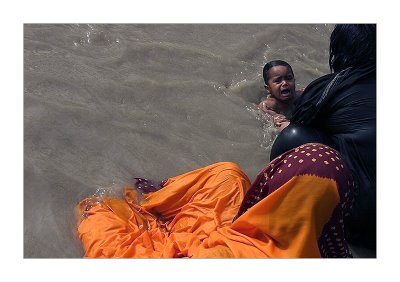
The first bathing of the baby in the sacred Ganges, in Haridwar, in the State of Uttaranchal. The frightened baby must have been rather cold, as I personally verified.
Haridwar has also been called Gangadvar, meaning 'Door of the Ganges' as it is here that the sacred river Ganges leaves the mountains to flow out upon the Indian plains
Pushkar: Ghats. Rajasthan
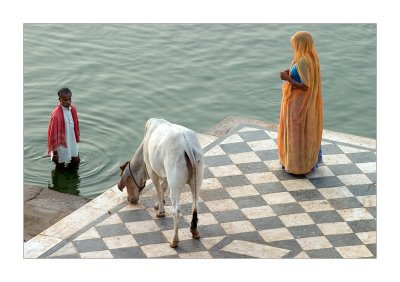
A scene of the Pushkar ghats in the morning. A woman, a man and a cow. A peaceful scene that can be witnessed every day in this little jewel of a town, all around the sacred lake. And this, despite the fact that the place has become a tourist “Mecca”.
The sacred Pushkar Lake is believed to have been created by the falling of a lotus from the hand of Lord Brahma. It is therefore considered to be as old as creation itself. It is certainly one of the most worshipped spots, and it is believed that one dip in the waters of the lake is equivalent to performing yagnas for several hundred years.
The charming lake amidst the hills has fifty-two bathing ghats, built all around it. The water next to each ghat is supposed to have special powers: the Naga Kund is believed to give fertility, Roop Tirth gives beauty and charm, Kapil Vyapi Kund water helps in curing leprosy and a dip in the Mrikand Muni Kund grants the boon of wisdom.
Agra: Praying. Uttar Pradesh

Morning. A woman praying to gods alongside the Sacred Yamuna river, one of the seven sacred rivers in the country, during the "Ganga" festival in Agra.
Agra came to its own when Shah Jahan ascended to the throne of the Mughal Empire. He marked the zenith of Mughal architecture, when he built the Taj in memory of his beloved wife Mumtaz Mahal.
The monument is magnificent, and is usually photographed from the front. I thought that changing the perspective and including the people in the river in the morning light (6.50a.m.), might give it a more real, lively look.
Varanasi: Woman On The Ghats. Uttar Pradesh
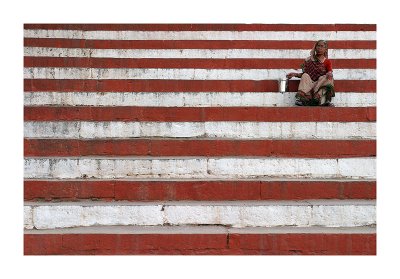
A woman sitting on the white and red-striped ghats, not far from Assi ghats in Varanasi. I couldn’t resist the pun in French (Assi sounds like “assis” = sitting). Those ghats lead to a temple and the stripes mark the sacredness of the area.
Benares has been a pilgrimage centre since time immemorial. It is believed that the fifth head of Brahma which clung to Shiva's palms, came unstuck only after he reached Varanasi. The town is mentioned in the Tamil Tevaram hymns of the first millennium. Kasi repeatedly appears in scriptures such as the Brahmanas, Upanishads, Kavyas and Puranas. It is the oldest centre of learning and is vibrant with centuries of tradition. The last of the sacred spots is the Manikarnika Ghat. Legend has it that Vishnu dug a pit with his chakra, and the sweat created during his meditation filled the pit. Shiva shook his head and his jewelled earring fell into the pit, hence the name Manikarnika. According to tradition, those that die at Benares and get cremated at the Manikarnika ghat, get liberated from the cycle of life and death.
Hyuen Tsang, the Chinese traveller visited Varanasi in the 7th century. His travel accounts speak of the grandeur of the city and of its temples. This writer describes a hundred feet high statue of Shiva Maheshwara made of brass that adorned the city. Several other temples and shrines abound in the city of Benares. Virtually every block houses a shrine here.
Varanasi: Old Man And Grandson. Uttar Pradesh

Varanasi is a very special town. I love it. I truly believe I could spend months there strolling on the ghats alongside the Ganges. This image was taken early in the morning, not far from Assi ghats. This elderly man taking care of his grandson was a touching scene for me.
Varanasi - Benares - Kaasi is considered to be the holiest of all pilgrimage sites in India. It is considered home to Shiva -
Visweswara. Benares is also known as Kaasi because it is believed that Supreme brilliance shines there, and lights the way to salvation (Kas - to shine). Varanasi is located between two rivers Varana and Asi, hence the name Varanasi.
This place is said to give the greatest delight to God: the five elements lie in this great cremation ground.
Erode: Waiting Outside The Temple. Tamil Nadu
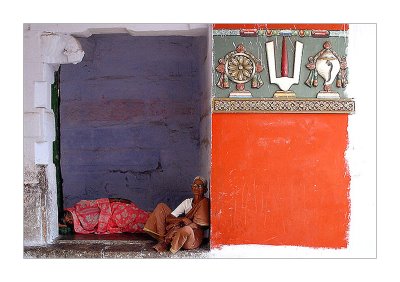
Two women waiting for the Perumal temple to open up, in Erode, a town in Northern Tamil Nadu, not on the tourist trail. Neither the city nor this specific temple are particularly important, the frieze with the Vishnu symbol is rather simple, if compared to the ones in most of the temples in this State, but this scene is to me of the greatest relevance, because it represents that peaceful feeling I so often had in Tamil Nadu and it has those powerful colours that I like to present flattened on the picture.
Omkareshwar: Women, Sari, Boat
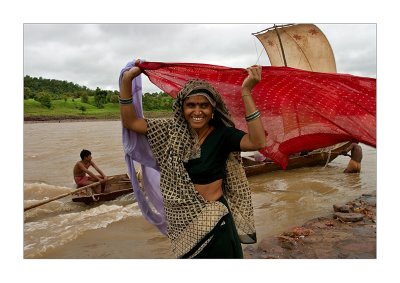
A woman drying up a sari at the confluence of the Narmada and Kavery rivers in Omkareshwar. Omkareshwar is an island, shaped like the holy Hindu symbol of ‘OM'.
Thousands of pilgrims gather at this holy city to offer prayers to the Jyotirlingam (one of the twelve throughout India), at the Shiva temple of Shri Omkar Mandhata. The jyotirlingam and the shape of the island combine to increase the religious importance of the island for devout Hindus.
Tiruchendur: Tired Pilgrim

A tired pilgrim, trying to hide from the scorching sun, is waiting for the opening of the temple in Tiruchendur. Tiruchendur is one of the six Aarupadai veedu shrines of Murugan.
It has been venerated by the Tamil Sangam literature and is one of the most visited shrines in Tamil Nadu. It is located on the seashore in the southern part of the state between Tirunelveli and Kanyakumari.
Madurai: During The Chitrai Festival

An old pilgrim during the Chitrai festival in Madurai. Celebrated for 12 days during the Tamil month of Chitrai, the festival begins with the flag hoisting on the first day. On the 8th day the coronation of Meenakshi Amman takes place. On the 9th day the Goddess is taken out in procession. On the 10th day the celestial wedding of Goddess Meenakshi and Lord Sundareswarar is performed, followed by a chariot festival the next day; Theertha festival is celebrated on the 12th day with the Lord and Goddess going round Masi streets. This picture was taken on this occasion.
Pilgrims on the beach. Mamallapuram

A family of pilgrims from the state of Andhra Pradesh, visiting Mamallapuram, 60 kms, South of Chennai. Nestling on the shores of the Bay of Bengal, the town was once a port of the Pallava Dynasty. The Pallavas created many marvellous monuments with Sculptural Panels, Caves, Monolithic Rathas (stone chariots) and Temples.
Once a thriving port trading with many distant nations, nowadays Mamallapuram is still a big sculpture centre. You can wake up in the morning to the unceasing sound of the chisels gently carving the stone. Apparently, the tradition of Pallava sculpture has never abandoned the place.
Inscription à :
Articles (Atom)

